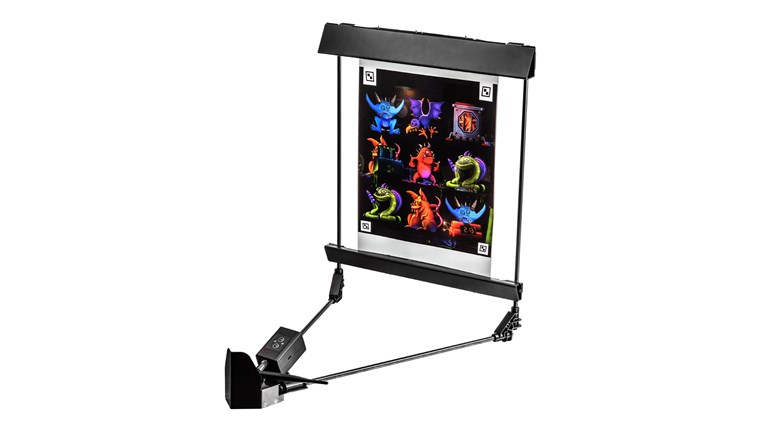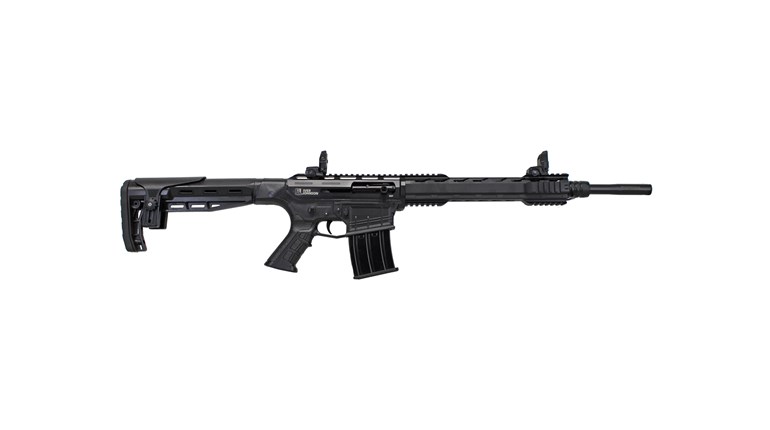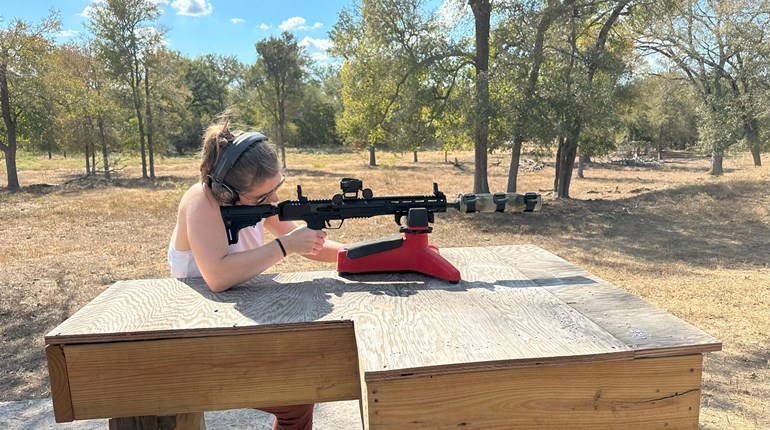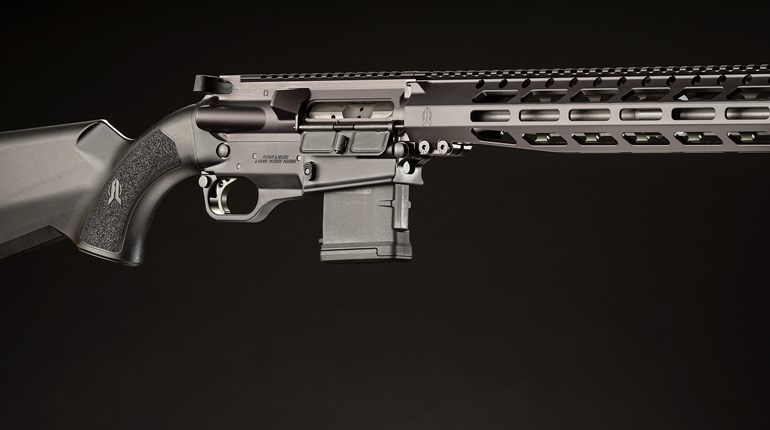
A lot of work has gone into better, heavier bullets—bullets have gone from 55 grains to 62—but the gains in energy and long-range performance have been minimal. Green tip or long, the bullet is still .22 caliber, can go only so fast at AR-operating pressures and only delivers so much energy. Companies have developed AR-15-like rifles chambering more potent rounds from 7.62 NATO/.308 Winchester to some of the new short magnum cartridges. But those rifles are heavier, have more recoil and just don't have the handy, nimble feel of an AR.
The Concept
Bill Alexander is one of the many talented engineers who has thought long and hard about a solution, but it took the end of the Cold War for him to introduce a gun that meets all the requirements of long-range shooters and those who just wanted more out of an AR-15. Alexander's specialty was in armor and armaments for main battle tanks. When NATO no longer needed to stop mass tank attacks in the Fulda Gap, Alexander knew defense budgets would soon be spent elsewhere. "I turned my attention to ARs," Alexander said. "They are great rifles, a great system, but I wanted to make it a little more versatile."
The base case was the intrinsically accurate 6 mm PPC, a benchrest competition round that fits handily into an AR magazine. Alexander stepped the diameter up to 6.5 mm, shortened the neck, moved the shoulder forward and created what he and many others see as the most versatile and accurate AR cartridge available—the 6.5 mm Grendel. Any new cartridge has growing pains, and the Grendel was no different. Because the operating pressures are fairly low and no major modifications other than sizing the bolt head and moving the extractor had to be made to the gun, the rifles were simple enough. Brass, or large quantities of it, was the catch.
"The biggest manufacturing problem is not guns, but to find a source for brass," Alexander said. "Everything else you can make in your own shop, but very few companies can step up and make brass. By chance, I met a guy from Lapua at the SHOT Show several years ago and he said, 'Sure, we can make that.' Luckily, it turns out the case is pretty easy to make, and the defect rate is amazingly low."
With a source for high-quality brass, Alexander moved across the Big Pond and set up shop in the middle of a U.S. Army arsenal in Radford, VA, hopeful his cartridge and custom rifles could fill the performance vacuum left by .223-chambered rifles. Once Alexander Arms was up and running, the company had to decide to whom it should market its rifles. That is where the amazing versatility of the 6.5 mm chambering gives Alexander an advantage, the round can do just about anything with the right bullet.
A quick look through reloading manuals lists bullets from 85 grains up to 144 grains in any configuration, from varmint to super match. But like any caliber with such a diverse range of bullet weights, the twist rate has to match, at least to a degree. Alexander had to make changes in his barrels to account for the dramatic differences in bullet length and ogive radii.
"Ogives run from 6 diameters to 19 diameters," Alexander said. "We had to figure out how to make guns shoot the huge diversity of bullets. We did this with a compound throat. It replaces the traditional free-bore and throat angle with a series of differing throat geometries, three different angles. It fools the bullets into thinking they are all jumping the same distance to the lands."
Twist rates—most Grendel barrels have a 1:8 twist—are geared toward heavier match bullets with the thought that you cannot over-stabilize light bullets, but need to have a fast twist for the big match bullets.
"The Grendel can put you in a quandary," Alexander said. "Most of my rifles are tuned for long range. The cartridge is designed for 1,000 yards, but some guys only shoot out to 200 or 300 yards, and the rifles don't shoot to their full potential with light bullets at short ranges. If I were making the perfect barrel for short-range work I would use a 1:13 twist and load flat-base bullets, but we have to make rifles that will shoot everything well."
As it stands now, accuracy with varmint and hunting bullets is above average, and exceptional with heavy match bullets.
After solving some unique ballistic and engineering challenges, Alexander had a cartridge that met or exceeded all the performance goals he set—and was able to do it with a cartridge that did not change any of the interior dimensions of a standard AR receiver. The bullet selection allowed the rifles to fit nicely into a role hunting varmints or small- to medium-sized game animals and deliver much more energy and penetration than the best .223 bullet available. Competition shooters now had a cartridge that picked up where the .223 started to fall off, around 500 or 600 yards, and exceeded the performance of the venerable .308 Winchester at the 1,000-yard mark.
The Go-Anywhere, Shoot-Anything Rifles That Shoot
Now that Alexander had a great cartridge and a gun design that would shoot almost any bullet, he introduced several different rifles to match the needs of the different AR communities. I had the chance to wring out two different Alexander Arms rifles, and in the process learned why a lot of different shooters consider Alexander's rifles as good as his cartridge.
Like most AR shops, Alexander sends out a set of specs to different machine shops and then assembles the parts. He holds his vendors to exacting tolerances and then uses a few tricks during assembly to maximize accuracy potential.
Each rifle starts with a receiver manufactured by a division of Boeing that specializes in aircraft engine parts. The original cost-per-unit bid was around $2,000—just for the bare receiver—until Alexander explained to the engineers there that ultrasound, X-ray and displacement tests were nice but not necessary. Needless to say, the receivers are high quality.
The receivers are standard in every way with a few exceptions. They are first dyed black before anodizing to eliminate any differences in color before sealing and anodizing. The ejection port is .002-inch taller. There are two critical tolerances to which Alexander pays particular attention. The first is the angular tolerance on the top rail, which assures it is perfectly in line with the axis of the bore, because a thousandth of an inch on the firing line equates to several feet at 1,000 yards. They also have a tighter barrel extension fit because the Grendel's heavier recoil "explores" all the loose spots, and the barrel will settle in a different position each time if given the room.
Wandering groups in well-worn test rifles also taught Alexander that he needed to bed the barrels and gas blocks. Under a microscope, the surface of anodized metal looks like a forest of microscopic Christmas trees. Over time, those Christmas trees lose their tops and the rifle's groups open up. Alexander beds the barrels with 2440 Locktite, which fills in the gaps but allows the barrel to be removed with standard tools. The gas block is seldom a problem, but has bounced loose on a couple of rifles. Alexander doesn't take any chances and beds both parts on all his rifles.
The barrel is the heart of any rifle. Grendel rifles have tubes from Lothar-Walther, a name familiar to anyone in the competition or custom-rifle world. A slight step-down at the muzzle allows competition shooters to fit a match front sight or bloop tube to the end of the barrel and provides a secondary shoulder that is set back from the muzzle for the attachment of a muzzle brake or flashhider.
Some rifles have a custom trigger designed by Alexander that is an interesting hybrid between a standard and match trigger. The unit is fully adjustable and breaks like the proverbial glass rod. It is unique in that it has a very narrow trigger face, a feature that was a little disconcerting to most of those who shot the rifle during testing.
"The narrow trigger bow gives you a better repetition, though I know the target guys like a wider bow," Alexander said. "There are a number of great target triggers, but few tactical triggers. You can use this trigger with gloves or under really sloppy conditions. It has no advantage on the target range, but it's great in cold weather when wearing gloves."
After a thorough look at the cartridge and rifle particulars, I was anxious to see how they shot. I took two Grendels—the Overwatch (OW) and the Grendel Designated Marksman Rifle (GDMR)—and two good friends, Graham Wood and Bruce Furr, both experienced shooters, to the range.
One of four variants currently available, the Overwatch rifle has a flat-top receiver and a 24-inch, hand-lapped, stainless steel barrel with a match chamber. A standard A2 buttstock and free-floating, composite handguard with twin sling-attachment points round out the furniture. Alexander uses a billet, not extruded, one-piece buffer tube made of high-quality 7075-T651 aluminum. The extra-strong tube allows Alexander to cinch down the buttstock tighter, making sure the shooter has a solid and consistent bond with the rifle.
I mounted the Nightforce NXS 3.5-15x50 mm with a mil-dot reticle in Nightforce rings for OW testing. Seeing a sharp, clear target and making precision adjustments were the least of our worries with this awesome optical instrument.
The GDMR uses an Alexander Arms receiver and the contract Lothar-Walther barrel (19.5 inches long), but little else could be considered Alexander stock. The gun has a LaRue rail, throw-lever scope and bipod mounts. Iron back-up sights are from Troy Industries and the infinitely adjustable stock and grip are from Magpul. The gun came with a Leupold 3.5-9x36 mm Mark 4 scope. The GDMR is high-speed and is guaranteed to draw a crowd at the range.
We shot two different bullet weights in cartridges loaded by Alexander Arms. The 90-grain Speer TNT and 123-grain Lapua Scenars grouped between ¾ inch and 1-½ inches at 100 yards—the kind of accuracy you would expect. But when we moved the targets out to 200 yards, I was surprised to see groups open up only 1⁄8 to 1/4 inch at the increased range.
Alexander said he expects his guns to shoot minute-of-angle at any range. The guns seem to favor the lighter bullets, often putting two of three shots in the same hole or close to it. True to Alexander's predictions, the heavier bullets "don't sort themselves out until they've gone a few hundred meters." It is a phenomenon I have read about, but never experienced.
Recoil, obviously, was slightly more than a .223, but much lighter than the .308 Winchester. The rifles are very comfortable to shoot, including the radically stocked GDMR. In short, the guns are like many other custom ARs I have fired, but they are a little more accurate and the hole in the end of the barrel measures 6.5 mm.
But feel and function is where the similarity ends with standard-caliber AR rifles. The Grendel is capable of handling just about any shooting situation from prairie dogs to deer hunting to punching paper at 1,000 yards. The price paid in recoil is negligible. The concept is solid and the cartridge performs as advertised. If you like AR rifles and need one that will just about do it all, the Grendel is your best bet.
Finding ammo is the only fly in the Grendel's ointment. Currently you can buy loaded ammunition from Alexander Arms for about $1 a shot. Alexander ammo uses only the best components and is worth the money. Alexander has also worked out a deal with Wolf Ammunition to produce brass case, boxer-primed Grendel ammo. It should fill the gap with wallet-friendly plinking ammo. Lapua is also putting the finishing touches on production ammo as well.
Reloading dies are available from Lee, and rolling your own will always maximize a rifle's performance. Loading data is available from Alexander Arms and the Internet is a great resource as well. In addition to the Alexander Arms website, shooters can find a wealth of information on www.65grendel.com, especially in the forum section.
What do these great rifles cost? You can find "match" guns that cost less, but few put the kind of work and attention or high-quality parts into their rifles like Alexander Arms. You can also find some match guns that are almost double the price. An Overwatch upper will run around $900, while a complete rifle can be had for $1,700. The ever-so-wicked GDMR is another story.
"Up until now, we have built what I call plain-jane guns like the Entry and Overwatch models," Alexander said. "The GDMR is our first fully dressed rifle. It costs $2,950, and includes everything but the scope. A majority of that cost is accessories. The back-up iron sights alone are close to $300. Everything on that gun is top-notch. I don't make any apologies for my prices, because I think you are getting the absolute best rifle we can build for the money."
After a few weeks with two of his rifles and several hundred rounds of 6.5 mm Grendel downrange, I would agree. I plan to try and take the Grendel on a prairie dog shoot and to the woods for some deer and coyote hunting this fall. With enough practice, I might even venture out to my first rifle match with the Overwatch. On the firing line or in the stand, I know the Grendel will perform, as long as I do my part. My search for the "perfect" AR and cartridge, a mythical beast for sure, has ended with a Grendel rifle from Alexander Arms.




































